What if the secret to understanding Algeria’s rich culture lies in a simple grain? Couscous is not just a traditional North African dish; it’s a beloved staple. It reflects the heart and soul of Algerian culinary traditions. In this Algeria: Couscous guide, you’ll discover why authentic Algerian couscous is more than mere food. It connects families, celebrates occasions, and embodies centuries of history.
From exploring its historical roots to unveiling regional variations, this guide will take you through the essential ingredients, traditional recipes, and even the health benefits associated with couscous. Dive in, and let your taste buds experience the diverse flavors found across Algeria’s vast landscapes!
Key Takeaways
- Couscous is a vital component of Algeria traditional dishes, symbolizing cultural heritage.
- The dish is made with various meats and vegetables, highlighting Algeria’s diverse cuisine.
- Special spices like ras el hanout add unique flavor profiles to couscous.
- Understanding how to prepare couscous is key to experiencing authentic Algerian meals.
- Homemade couscous is often steamed multiple times for enhanced flavor and texture.
- Health benefits include its status as a wholesome, versatile dish suitable for various diets.
Introduction to Couscous
Couscous is a key part of North African cuisine, especially in couscous Algeria. It has a long history, starting in the 9th century. It’s made from steamed semolina wheat, making it a great base for many dishes.
To make it, you mix water and semolina flour. This creates a light, fluffy texture. It goes well with lots of different ingredients.
This dish is often enjoyed at big events like family gatherings and religious festivals. In Algeria, different areas have their own ways of making couscous. For example, in Constantine, they add lamb, onions, carrots, and spices like ras el hanout.
Couscous is more than food; it brings people together in Algerian culture. It’s a symbol of community and friendship. It’s also good for you, full of complex carbs, fiber, and vitamins.
Learning about its history of couscous and its role in Algerian food makes us appreciate it more. It shows how simple yet meaningful this dish is.
The Significance of Couscous in Algerian Culture
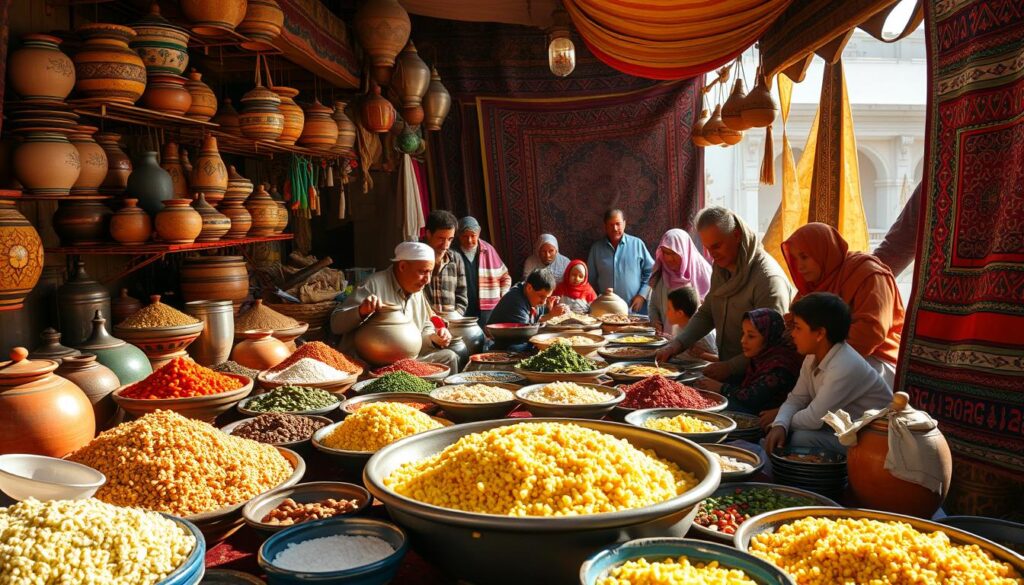
Couscous is deeply rooted in Algerian culture. It’s a staple at family gatherings, weddings, and religious events. It brings people together, showing unity and community spirit.
Meals with couscous strengthen family and friend bonds. They become a key part of Algerian food culture.
Couscous is more than food; it’s a symbol of life and comfort. In Algeria, it’s called “Taam,” showing its vital role in daily life. In different areas, couscous traditions are celebrated with stories, music, and art.
Algeria sought UNESCO Intangible Cultural Heritage status for couscous in 2016. This move brought global recognition. Efforts with Morocco and Tunisia highlight the Maghreb’s shared culinary heritage.
Despite challenges, like a closed border with Morocco, the tradition’s preservation is a priority. Couscous is a common dish in the Maghreb, enjoyed on weekends and special days. It’s a symbol of cultural identity and tradition.
Algeria: Couscous Guide
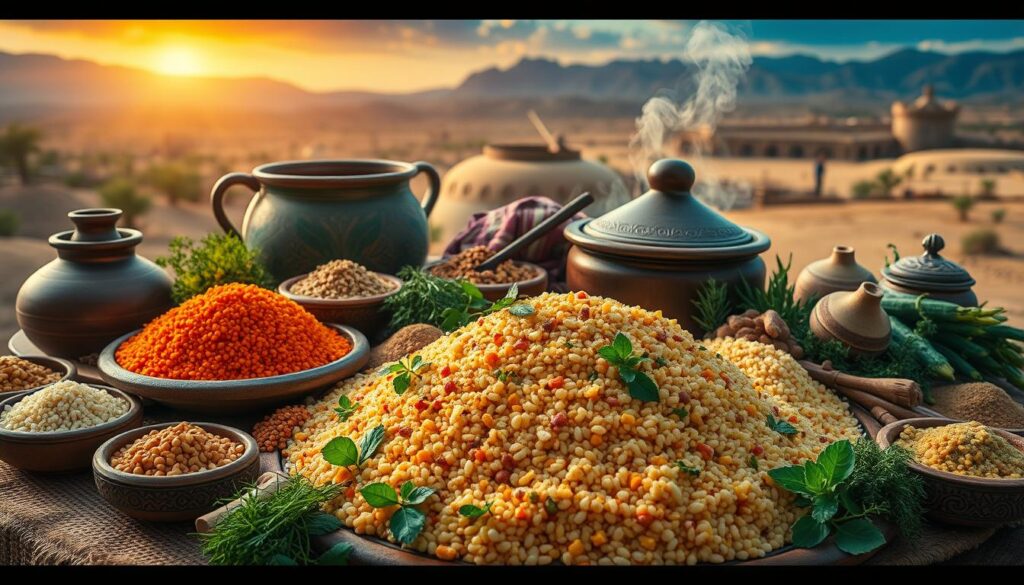
Couscous has a deep history in Algeria, showing its roots and growth over time. It’s a key part of Algerian culture, coming from ancient Berber traditions. The dish’s history is shaped by many cultures, like French and Ottoman.
In Algeria, couscous is more than food. It’s about community and celebration.
History of Couscous in Algeria
Algeria’s couscous history spans centuries. It was first made by hand, using durum wheat. This grain is special because of how it’s prepared, with careful steaming.
Over time, couscous became a main food in Algeria. It’s loved in many provinces, where different tastes and ways of making it emerged. It’s a symbol of nourishment and coming together, adding to Algeria’s rich heritage.
Regional Variations Across North Africa
Couscous in North Africa is full of different flavors. Each country adds its own twist, making it exciting. In Algeria, the couscous is hearty, with spices like cinnamon and cumin.
Moroccan couscous is sweeter, with more varied recipes. Tunisian couscous is spicier, thanks to harissa.
Algeria has over 40 provinces, each with its own couscous style. This shows how couscous has changed but stayed important in North Africa. Every dish tells a story, blending flavors that celebrate culture and nourishment.
Essential Ingredients for Authentic Algerian Couscous
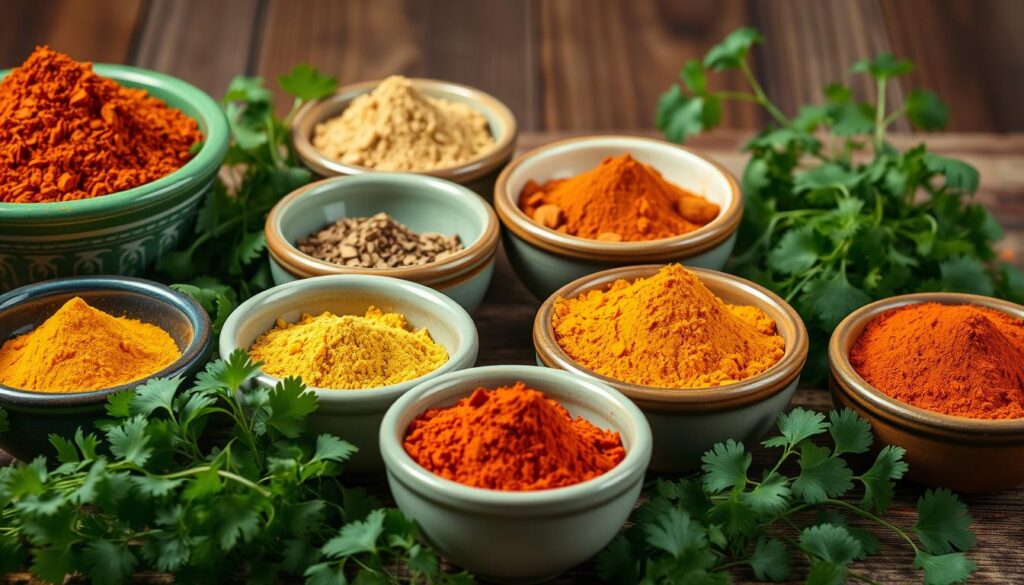
Making authentic Algerian couscous starts with the right ingredients. Choosing quality grains and spices is key. It makes the dish taste great and keeps its traditional flavor.
Types of Grains Used
The main ingredient is semolina grain from durum wheat. Algeria has many grains for couscous, each with its own taste and texture. Here’s a quick look at some:
- Coarse Semolina: It has a rough texture and is used in many traditional recipes.
- Fine Semolina: It’s finer and cooks faster, making it a popular choice.
- Whole Wheat Couscous: It’s healthier and adds a nutty taste.
Using these grains makes your couscous interesting to eat. Choosing the best ingredients is crucial for a great dish.
Herbs and Spices Essential for Flavor
Herbs and spices are vital for couscous’s flavor. Algerian spices and herbs make the dish special. Some common ones are:
- Ras el Hanout: A mix of herbs and spices that’s a key part of Algerian cooking.
- Cumin: It adds warmth and a rich taste.
- Coriander: It brings a citrusy flavor that enhances the taste.
- Cinnamon: It adds a sweet touch that balances out the savory flavors.
These spices and herbs not only make the couscous taste better but also connect us to Algerian cooking traditions. Try different combinations to find the perfect flavor.
Traditional Algerian Couscous Recipe
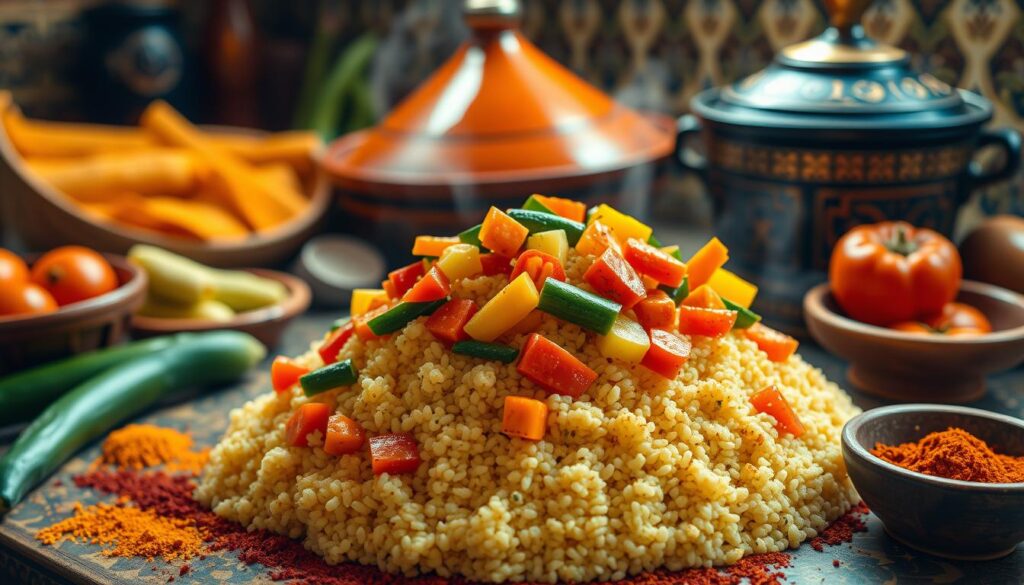
Making a traditional Algerian couscous recipe at home brings North African culture to your table. Follow these steps to get a light and fluffy couscous. Each bite will capture the essence of this beloved dish.
Step-by-Step Preparation Method
-
Gather your ingredients. You’ll need:
- 1.5 cups of couscous
- 4 chicken legs or 2.2 lbs of lamb shoulder or veal shoulder
- 2 medium baking potatoes, 1 large carrot, 1 large courgette, and 1 white onion
- 2 big ripe tomatoes, small bunch of parsley stems with leaves
- 1 cup of chickpeas in water
- 2 cloves of chopped garlic
- 2 large carrots, 2 medium turnips, and 1 large zucchini or 5 baby zucchinis
- 2 cups of fresh green beans and ½ cup of chopped fresh parsley
- 4 tablespoons of olive oil and 2 tablespoons of ghee
- 1 medium tomato and 3 tablespoons of tomato paste
- Spices: salt, black pepper, ground paprika, ground coriander, a bay leaf, and sugar
- Hot water for the stew (approx. 4.25 cups)
- Prepare the couscous by mixing 1.5 cups of couscous with 1 tablespoon of olive oil and 1 teaspoon of salt. Add 1.5 cups of room temperature water, allowing the mixture to absorb for about 10 minutes.
- In a large pot, heat 4 tablespoons of olive oil and brown the meat. Then add the chopped onion and garlic, letting them soften.
- Incorporate all the vegetables, spices, and chickpeas into the pot. Pour in the hot water. Allow the stew to cook on medium-high heat for around 1 hour.
- As the stew simmers, start cooking your couscous. If using a couscoussier, place the soaked couscous in the top section and steam it for about 30 minutes, ensuring the grains remain fluffy. You can also opt for couscous cooking methods that involve just boiling for convenience.
- Near the end of the stew cooking time, boil the green beans for 10 minutes until tender.
- Once everything is ready, serve the couscous topped with the stew and garnish with fresh parsley.
Cooking Techniques for Couscous
Steaming couscous is key for that perfect fluffy texture. Traditional methods stress not overcrowding the grains. Use the right water amount and let the couscous rest before serving. Mastering these techniques will make your couscous preparations authentic and delicious.
Understanding the Couscoussier
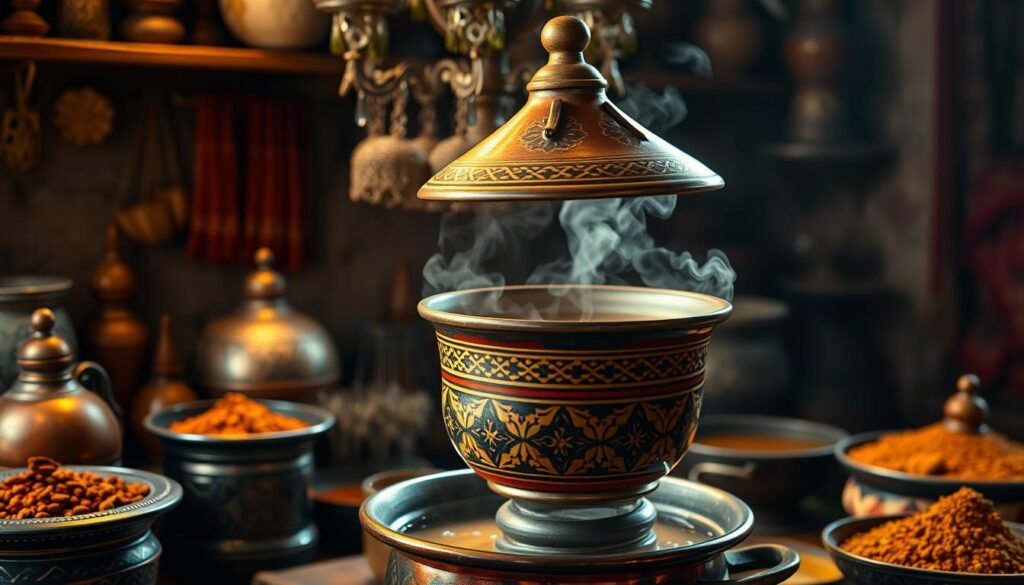
The couscoussier is key in Algerian cooking, especially for couscous. It has two parts: a lower pot for steaming and an upper for couscous. This setup ensures the couscous cooks evenly and absorbs flavors well.
Learning to use the couscoussier is an art. It takes skill and patience. You steam the couscous three times to improve its taste and texture. You can also add spices or herbs to the liquid for extra flavor.
Here’s a look at different cooking tools in an Algerian kitchen:
| Cooking Tool | Purpose | Couscoussier Utility |
|---|---|---|
| Tagine | Slow-cooking dishes | Allows for versatile cooking styles |
| Merhaz | Grinding spices | Can be used alongside couscoussier for well-seasoned couscous |
| Cocotte minute | Fast cooking | Not used for couscous, but serves other quick dishes |
| Couscoussier | Steaming couscous | Essential for authentic couscous preparation |
The couscoussier is more than just a tool. It’s a symbol of Algerian culture. By learning to use it, you connect with those who have made couscous for generations. It brings Algerian flavors into your kitchen.
Famous Algerian Couscous Dishes
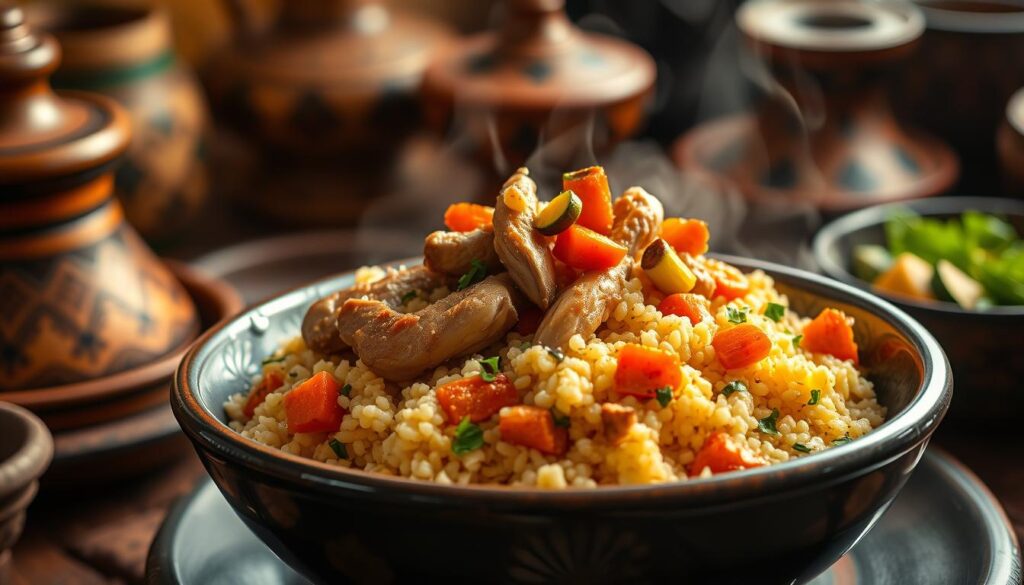
Couscous is a big deal in Algerian food, with many famous recipes. Two favorites are couscous with chicken and lamb couscous with vegetables. They are loved by many and often served at family meals.
Couscous with Chicken
This chicken couscous recipe is a favorite in Algerian homes. It starts with simmering chicken in a flavorful broth with spices. The couscous and chicken are layered together for a perfect mix of tastes.
Carrots and zucchini are added on the side, making the dish even better. Fresh herbs like parsley and mint add a nice aroma. Olive oil makes it rich and satisfying, making it a hit at family dinners.
This dish is perfect for family gatherings. It brings everyone together with its hearty flavors.
Couscous with Lamb and Vegetables
The lamb couscous recipe is loved for its comforting taste. It uses a seasoned lamb shoulder with vegetables like turnips and zucchini. The lamb’s simmering creates a flavorful broth that makes the couscous even better.
It’s seasoned with paprika and coriander, enhancing the natural flavors. Carrots and parsley add color and nutrition, making it a healthy choice. It’s a favorite at festive gatherings, where families enjoy good food and company.
Health Benefits of Couscous
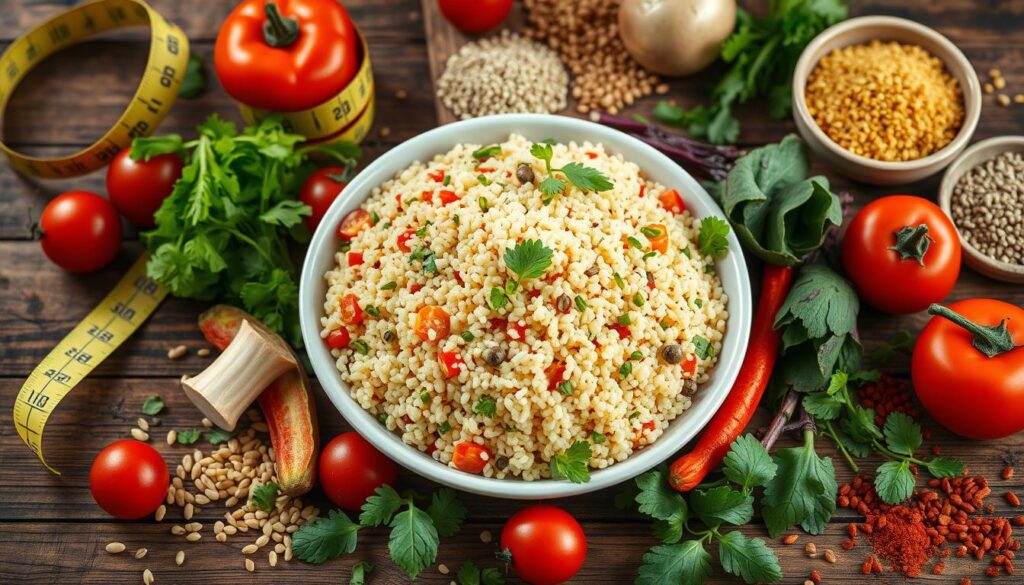
Couscous is not just tasty but also good for you. It’s full of nutrients that make it great for any diet. Knowing what’s in couscous helps you see its value in nutrition and meal planning.
Nutritional Value of Ingredients
The health perks of couscous come from its ingredients. One cup of couscous has:
| Nutrient | Regular Couscous (per 1 cup) | Whole-Grain Couscous (per 1 cup) |
|---|---|---|
| Calories | 174 | 227 |
| Protein | 6g | 9g |
| Carbohydrates | 36g | 49g |
| Fiber | 2g | 8g |
Couscous is rich in plant-based protein and fiber, aiding digestion and providing vital nutrients. It also has selenium, offering over 60% of the daily recommended amount. This antioxidant helps repair cells and boost the immune system. It may also reduce inflammation and lower disease risk.
Couscous as a Versatile Dish
Couscous is a versatile dish that fits many diets. It’s a great base for meals, working well with veggies, proteins, or in salads. For vegetarians or vegans, couscous is a solid choice for adding healthy ingredients like roasted veggies or legumes. Plus, choosing gluten-free options like quinoa makes couscous accessible to everyone.
Tips for Perfecting Your Couscous
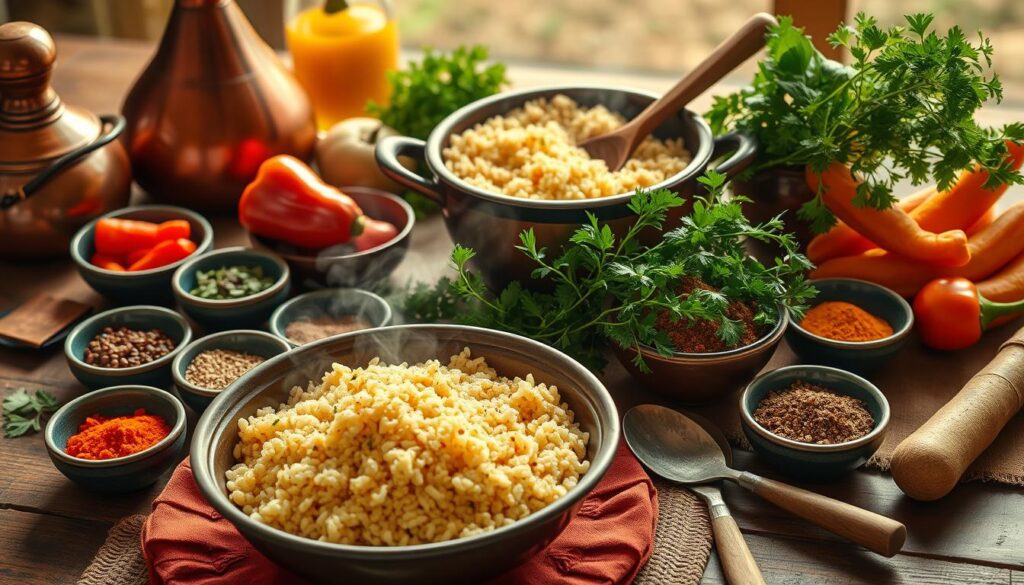
Getting couscous just right needs focus and some key tips. Use the right amount of water to couscous for fluffy results. Aim for 1 1/2 cups of water for every 1 cup of couscous. This keeps it from getting soggy or sticky.
Cooking couscous is quick. It takes about 12 minutes, with 3-7 minutes to boil the water. Then, it takes about 5 minutes for the couscous to soak up the water. Watch the timer to avoid overcooking. Remember, couscous doubles in size when cooked, so 1/2 cup becomes over 1 cup.
Think about how much couscous you need for your meal. For side dishes, 1/2 cup of uncooked couscous per person is good. For main courses, use 2/3 to 1 cup per person. For big gatherings, 4 cups of uncooked couscous can feed 10-12 people as a side.
Leftover couscous can be stored in an airtight container in the fridge for up to 3 days. This makes it easy to prepare ahead and reheat later.
| Serving Size | Uncooked Couscous (per person) | Cooked Couscous Yield |
|---|---|---|
| Side Dish | 1/2 cup | Approx. 1 cup |
| Main Course | 2/3 to 1 cup | Approx. 2 cups |
| Group Gathering (10-12 people) | 4 cups | Serves as a side dish |
Couscous is more than just the grains; it’s the flavors you add. Try using olive oil, onions, garlic, and fresh herbs to make it better. Follow these tips to master couscous and wow your guests with a great meal.
Pairing Couscous with Other Dishes
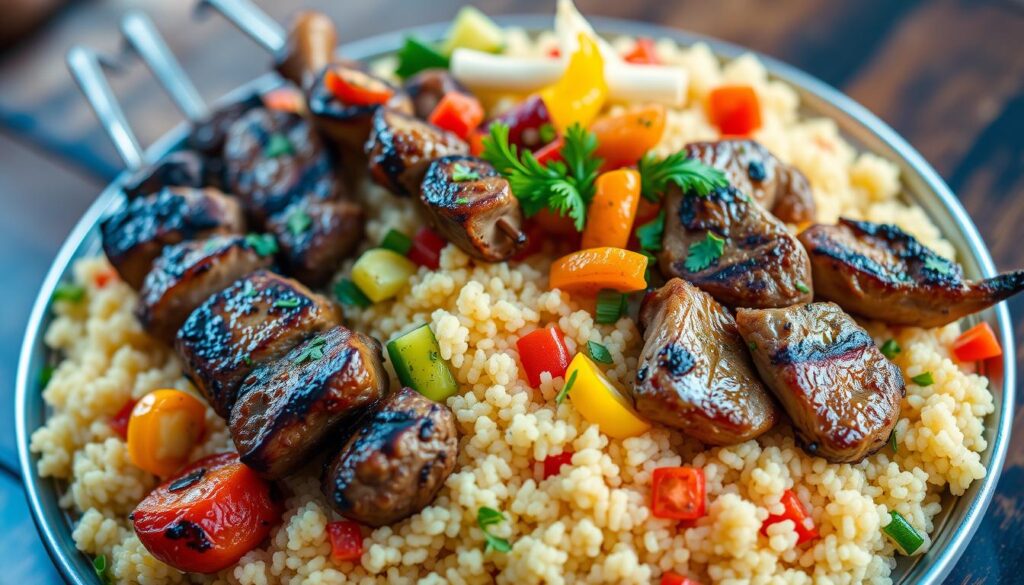
Adding the right dishes to your couscous can make your meal better in taste and health. Mixing different ingredients can lead to exciting pairings. Here are some great options for vegetables and proteins to go with couscous.
Complementary Vegetables and Proteins
For vegetables, pick vibrant ones that add color and flavor. Some top picks include:
- Grilled zucchini and bell peppers for a smoky taste
- Roasted carrots with olive oil and spices for sweetness
- Steamed broccoli with lemon juice for a bright flavor
- Cherry tomatoes sautéed with garlic for a zesty kick
For proteins, you have many options to match your meal:
- Marinated chicken, grilled to perfection, pairs well with couscous
- Lamb with fresh herbs and spices for a flavorful dish
- Spiced chickpeas for a tasty vegetarian choice
- Fish, like lemon-marinated salmon, for a modern twist
Try out these combinations for new tastes. Mediterranean styles with feta cheese and olives are refreshing. Quick-cooking couscous is perfect for fast meals or barbeques. Add almonds, parsley, lime wedges, or balsamic vinaigrette for extra taste.
| Vegetables for Couscous | Protein Pairings with Couscous |
|---|---|
| Grilled zucchini | Marinated chicken |
| Roasted carrots | Lamb with spices |
| Steamed broccoli | Spiced chickpeas |
| Cherry tomatoes | Lemon-marinated salmon |
Be creative with your couscous dishes. The right vegetables and proteins can make each meal special.
Conclusion
Couscous is more than just a dish; it’s a key part of Algerian culture and identity. It’s often served with stews, vegetables, and meats, showing its wide appeal in Algerian cuisine. Flavors in dishes like Chorba and Maklouba highlight how couscous enhances other foods.
Exploring Algerian cuisine, you’ll find dishes like Chakchouka, Mhadjeb, and Berkoukes. Each adds its own taste and texture to meals. The food scene, filled with markets, cafes, and festivals, invites you to explore more. It’s a call to try new couscous recipes and add them to your meals.
Learning about couscous and Algerian food shows how it inspires creativity and brings people together. As you explore Algerian cuisine, let couscous be your guide. Embrace its cultural importance and share meals with friends and family.

